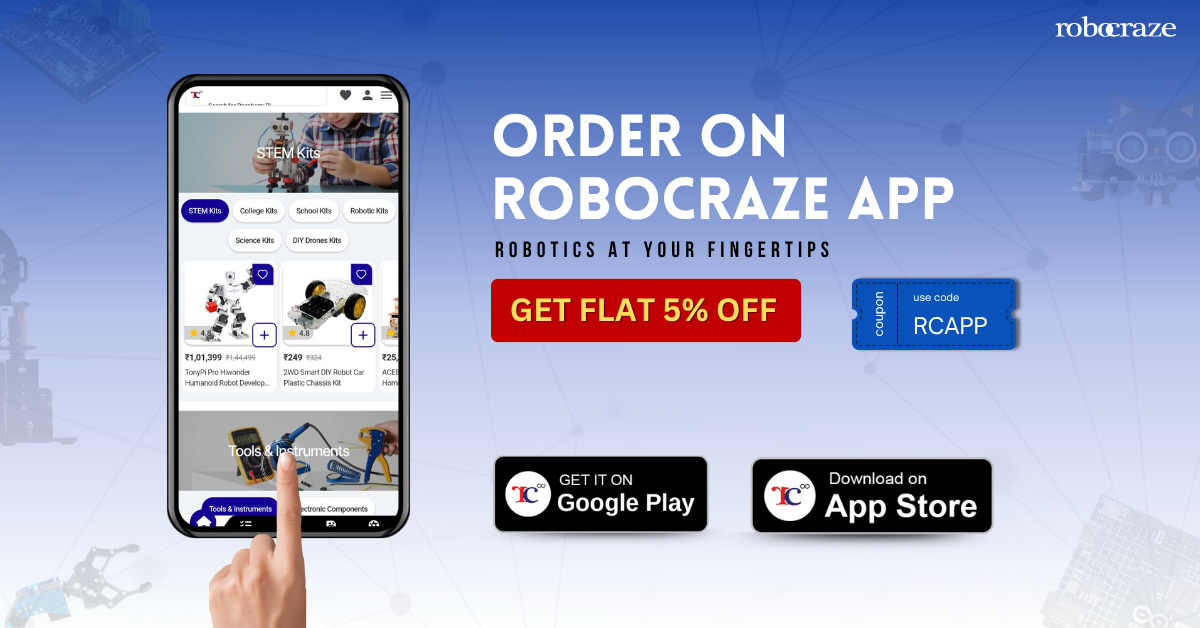Seeed Studio XIAO ESP32-S3 Development Board
The Seeed Studio XIAO ESP32-S3 Development Board is a compact and powerful ESP32 development board designed for IoT, smart home, wearable devices, and robotics projects.
Powered by a 240MHz Xtensa 32-bit LX7 dual-core processor, it supports both Wi-Fi and Bluetooth 5.0 for seamless wireless communication.
With its 2.4GHz rod antenna, reliable connectivity is ensured even in demanding environments.
The board also features an ultra-low-power deep sleep mode, consuming as little as 14μA, making it perfect for battery-powered applications.
Additionally, it includes lithium battery charging management, offering convenience for portable and energy-efficient projects.
Related Products
Features:
-
Powerful MCU Board: Incorporates the ESP32S3 32-bit, dual-core, Xtensa processor working at up to 240MHz, mounted multiple development ports, Arduino and MicroPython support.
-
Outstanding RF performance: Supports 2.4GHz WiFi and BLE 5.0 dual wireless communication, as well as 100m+ remote communication when linked with U. FL antenna.
-
Elaborate Power Design: Lithium battery charge management capability, offering four power consumption models, including deep sleep mode with power consumption as low as 14μA.
-
Thumb-sized Compact Design: 21 x 17.8mm, adopting the iconic XIAO form factor, appropriate for space-limited projects like wearable devices.
-
Perfect for production: Breadboard-friendly and SMD design, with no components on the rear.
ESP32-S3 vs ESP32-C3 – Speed & Performance Comparison
| Feature |
ESP32-C3 |
ESP32-S3 |
| CPU Architecture |
Single-core RISC-V up to 160 MHz |
Dual-core Xtensa LX7 up to 240 MHz |
| On-chip Memory |
~400 KB SRAM |
~512 KB SRAM with PSRAM support |
| Processing Capability |
Good for basic IoT and low-power tasks |
Ideal for ML, DSP, image/audio workloads |
| Wireless Features |
Wi-Fi 2.4GHz + BLE 5.0 |
Wi-Fi 2.4GHz + BLE 5.0 (higher throughput) |
| I/O & Peripherals |
Suitable for simple sensors and projects |
Supports camera, audio, ML, multi-sensor setups |
| Best Use Case |
Low-power IoT nodes & BLE devices |
Edge-AI, camera IoT, real-time automation |
Applications:
- Internet of Things
- Wearable devices
- Smart Homes
- Robotics
- Health monitoring
- Education
- Low-Power (LP) networking
- Rapid prototyping
XIAO ESP32-S3 Development Board Pinout Diagram
1. How to start using the XIAO ESP32-S3 as an Edge AI development board?
Connect the XIAO ESP32-S3 to your computer via USB-C and install the ESP-IDF or Arduino IDE board package for programming. This Edge AI development board leverages the ESP32-S3’s dual-core processor and vector instructions to run lightweight neural networks locally. Use it to deploy AI-powered vision or audio applications directly on the device. Enable USB serial/JTAG for debugging during development.
2. How to program the Smart device development kit for home automation?
Use MicroPython or the Arduino IDE to program the Smart device development kit, taking advantage of its Wi-Fi and Bluetooth 5.0 for seamless smart home integration. You can control relays, read sensors, or connect to platforms like Home Assistant or MQTT brokers. The compact size allows it to fit inside wall outlets or light switches. Always secure Wi-Fi credentials using NVS or encrypted storage.
3. How to turn the Portable IoT device board into a remote sensor module?
Attach sensors like DHT22, BME680, or PIR to the Portable IoT device board using GPIO, I2C, or ADC pins. Configure the board to wake periodically, collect data, and transmit it over Wi-Fi to a cloud server or local gateway. Its low-power modes make it ideal for battery-operated remote sensor module deployments. Use deep sleep with timer or external wake-up triggers to extend battery life.
4. How to deploy TinyML models on the TinyML wearable board?
The TinyML wearable board supports TensorFlow Lite for Microcontrollers, allowing you to run trained models for gesture or activity recognition. Convert your model to a C array, include it in your Arduino IDE sketch, and use the ESP32-S3’s DSP capabilities for fast inference. This enables real-time, privacy-preserving AI on the TinyML wearable board without cloud dependency. Optimize model size and sampling rate to match memory constraints.
5. How to build a wireless sensor network using the Wireless sensor development board?
Deploy multiple Wireless sensor development boards in a star topology, with each node sending data to a central Wi-Fi access point or MQTT broker. Use unique device IDs and timestamps to differentiate sensor streams for real-time monitoring. The ESP32-S3’s robust RF performance ensures reliable communication even in noisy environments. Implement OTA updates to maintain firmware across all nodes.
6. How to connect multiple smart devices with the Edge AI development board?
The Edge AI development board can act as a hub by simultaneously managing Wi-Fi and Bluetooth 5.0 connections to various smart devices. Use it to aggregate sensor data, run local AI decisions, and control actuators like locks or lights. Its dual-protocol support enables interoperability between Wi-Fi-only and BLE peripherals. Implement a task scheduler to balance wireless stack processing across cores.
7. How to troubleshoot connectivity issues on the Smart device development kit?
If the Smart device development kit fails to connect, verify Wi-Fi credentials and signal strength, and ensure the router allows device association. Update the firmware to the latest ESP32-S3 core version in the Arduino IDE. Check for IP conflicts or DHCP issues, and use serial logging to monitor connection attempts. A stable 3.3V power supply is critical—voltage drops can cause wireless instability.
8. How to integrate sensors and peripherals with the Portable IoT device board?
Use the Portable IoT device board’s GPIO, SPI, I2C, and ADC interfaces to connect sensors, OLEDs, or motor drivers for diverse IoT applications. Wire devices using level shifters if needed, as the board operates at 3.3V logic. Leverage built-in pull-up/down resistors and interrupt support for responsive peripheral handling. Group related sensors into functional modules for easier code organization.
9. How to optimize performance of the TinyML wearable board for low-power applications?
To extend battery life, use the TinyML wearable board’s ULP (Ultra Low Power) co-processor and deep sleep modes between inference cycles. Reduce sensor sampling frequency to the minimum required for accurate model input. Optimize the TinyML model to minimize MAC operations and memory usage. Power down unused peripherals like Bluetooth when only Wi-Fi is needed for periodic data bursts.
1. What is the Seeed Studio XIAO ESP32-S3 Development Board?
The XIAO ESP32-S3 is a tiny but mighty IoT projects board powered by a fast dual-core Xtensa® LX7 processor. It comes equipped with both 2.4GHz Wi-Fi and Bluetooth 5.0. This makes it the perfect choice for your next wireless and portable project idea.
2. What features make this board suitable for AI and machine learning projects?
This board is an excellent Edge AI development board because its processor includes special instructions for AI acceleration. Combined with its low-power design, it is perfect for running TinyML models directly on the device for real-time analysis. This brings intelligence to the edge.
3. Can this board be used for wearable devices?
Yes, the XIAO ESP32-S3 is an ideal TinyML wearable board for creating your own smart gadgets. Its incredibly small form factor, low-power consumption, and built-in wireless connectivity make it perfect for building all kinds of portable IoT devices, from fitness trackers to smart accessories.
4. How does the board support IoT development?
This board is a fantastic Wireless sensor development board that makes it easy to connect sensors and stream data to the internet or your phone. It uses its built-in Wi-Fi and Bluetooth 5.0 capabilities to create all kinds of smart systems, such as those for home automation or environmental monitoring.
5. What kind of projects can I build with this board?
This board is a powerful Smart device development kit that you can use to build almost anything you can imagine. With the XIAO ESP32-S3, you can create interactive smart home systems, intelligent robotics, custom portable gadgets, and even advanced edge AI applications.
6. Is this board suitable for portable IoT devices?
Absolutely, the XIAO ESP32-S3 is an excellent Portable IoT device board that is designed for battery-powered applications. It offers high-performance connectivity with both Wi-Fi and Bluetooth, making it a perfect choice for your creative on-the-go IoT projects.
7. Which programming environments are compatible with this board?
You have several great options, as this board is compatible with the Arduino IDE, MicroPython, and PlatformIO. This gives you amazing flexibility and allows you to choose the programming environment you are most comfortable with for this powerful IoT projects board.
8. How much memory and storage does the board have?
The board is well-equipped with 8MB PSRAM for running your applications and 8MB Flash for storing your code and data. This is plenty of space for running complex code and even small machine learning models on this capable Edge AI development board.
9. Can beginners use this board for IoT and AI projects?
Yes, the Seeed Studio XIAO ESP32-S3 is powerful enough for experts but also very beginner-friendly, making it a great learning tool. It serves as an excellent Smart device development kit for anyone who wants to dive into the world of wireless IoT, TinyML, and embedded AI.
Warranty Coverage:
This product comes with a 1-year manufacturer warranty from the date of purchase, covering manufacturing defects only.
Warranty Void If:
The product shows signs of physical damage, mishandling, exposure to water/moisture, fire, natural calamities, unauthorized repairs, improper storage near heat or direct sunlight, or alteration in any way.
























